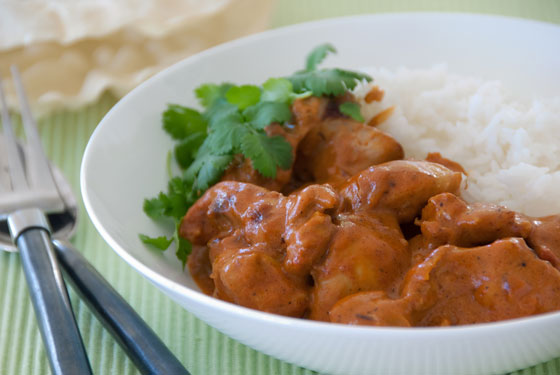
Virgil Evetts
Recently, when I asked Foodlovers readers about their takeaway favourites (and secret shame! how low do you go?) a common theme that emerged was a collective fondness for the flavours of India (and South East Asia), but a preference, given enough hours in the day, to make from scratch rather than ordering-in.
I’m certainly of this persuasion. While sometimes the day gets the better of me and I give into to wallet-sapping and often mediocre takeaways, I do prefer to self cater. Cost and disappointment aside, my main motivation is to understand what goes into my food – particularly in terms of where the formerly breathing components have come from. Free -range chicken, pork and eggs are almost unheard of in takeaway food (an exception to this is the excellent Pan Asia in Parnell, Auckland -reasonably priced great food using free-range chicken etc), and that’s a serious problem for me.
But doing in-house takeaways doesn’t mean settling for lesser dishes or spending hours in the kitchen. On the contrary. If you think about it, most of dishes that feature on takeaway menus – especially those of an Asian persuasion – have emerged from the street food cultures of their various cuisines. By its very nature, street food is quick and easy to prepare, relying on fresh produce, smart, punchy flavours and alluring aroma. With the right recipe and a little know-how there’s nothing to stop you from giving your local a serious run for their money.
Butter Chicken is easily one of our best-loved takeaways choices. Although technically a curry, it’s mild on the heat scale with a fragile complexity of flavour, and an extravagantly creamy, silken sauce. What’s not to like? Butter Chicken (or murgh makhani ), like much of the Indian takeaway food available in New Zealand, is a Mughali dish, meaning it hails from the courtly cuisine of the Mughal empire which ruled India for many centuries. Mugahli dishes are typically meat -based (unlike most contemporary Indian food) and laden with butter, cream and yoghurt. Although excessive heat is not typical, Mughali dishes are famous for their measured, yet drop-dead sophisticated, use of aromatic spices.
I’ve toyed with more Butter Chicken recipes than I care to recall, with mixed results, but this one, submitted by Foodlovers reader Irene Field is just outstanding. It’s creamy, rich and sophisticated, but easy enough to throw together after work. The sauce also works very well chickpeas, dahl or potato if you don’t do flesh.
India’s massive vegetarian population has had centuries to perfect the meat-free diet, and in my opinion they do it better than anyone else. Whereas many western vegetarian dishes are exercises in denial and substitution, Indian vegetarian cooking can be true foodie nirvana. To taste the best of this you really need to either visit India (not entirely practical of a weeknight) or find a South Indian restaurant or takeaway joint. Unfortunately these are pretty thin on the ground.
Chickpea curry, or chana masala is a one of the few vegetarian dishes to regularly feature on local Indian takeaway menus, and it’s a real crowd pleaser too. This home-made rendition is a favorite in our house. Chickpeas are an excellent, protein-rich alternative to meat and a few tins in the pantry will always come in handy.
Dahl appears in many forms in Indian food (and is the main source of protein for around 220 million Indians), from thin soups to rich, chunky curries. This dahl makhani sits somewhere in the middle and is a bit like a second cousin to the aforementioned butter chicken. If you don’t like dahl (which makes you a bit peculier really), this might just be the recipe that changes your mind.
Due to the sacred status of cows in the Hindu belief system, beef does not feature widely in Indian cooking and while Pork is not forbidden, it is regarded as ‘unclean’ by most Hindus. The most common red meats consumed in India are goat and lamb, with the latter considered something of a delicacy. This wonderfully fragrant Lamb korma is a truly regal dish (like butter chicken it has its roots in the Mughali royal repertoire), and a great choice for those afraid of very spicy food. Kormas use the uniquely Indian technique of thickening sauces with pureed cashew nuts, which impart a luxurious and distinctive sweetness. If I really want to please the punters I add a generous pinch of saffron to this recipe and finish it with a sprinkle of fluttering edible gold flakes.
After gorgeous, cardamom-scented Basmati rice, the best accompaniment for these, and indeed many Indian dishes – is naan bread . I use this recipe regularly with excellent results. Naan is traditionally made in a tandoor oven (ferociously hot clay contraption), so to get the best results at home you need plenty of heat. Use a Pizza stone if you’ve got one and pre-heat your oven to the point of combustion first!
Half the pleasure of Indian food is in the vast array of snacks and side dishes- pakora, puri, bhaji and most famously samosa. These vegetable samosa are easy to make and freeze really well – not that you’re likely to have left-overs once your friends and family catch wind of them!
Beer is often presented as the best drink to partner with Indian food. I can’t really comment as I don’t touch the stuff, but I do know that a deliciously soothing mango lassi does a great job of countering excessive chilli-burn. Makes a fine breakfast drink too.
Mango Lassi
(Can also be made with apple, sour cherry, apricot or pomegranate juice)
Ingredients per person
½ glass mango nectar/ fruit juice
3 heaped tablespoons plain, unsweetened yoghurt.
milk
Sugar (optional)
Ground cardamom
Finely chopped pistachios.
Method
Assemble drinks in chilled tall glasses. Ensure all wet ingredients are well chilled. Combine mango juice and yoghurt and stir until smooth. Top up with milk, add sugar (if using) and stir again until smooth and thick. Garnish with a fine dusting of cardamom and a scattering of chopped pistachio nuts.

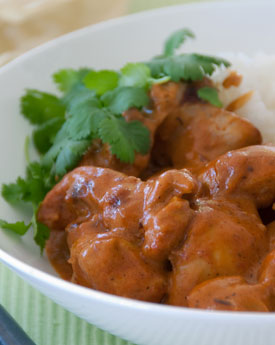

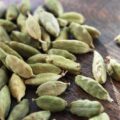

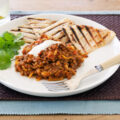
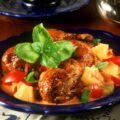

I am an Indian and I found this article really well-researched. Mostly, articles about Indian food recommend use of bottled sauces and pastes whereas it is really easy to make everything at home from scratch. I am going to start a series on my blog where I write about popular Indian recipes. You can visit me there. Once again, I commend the research put into the article. Getting the facts right is the first step to a good piece. Well done!!